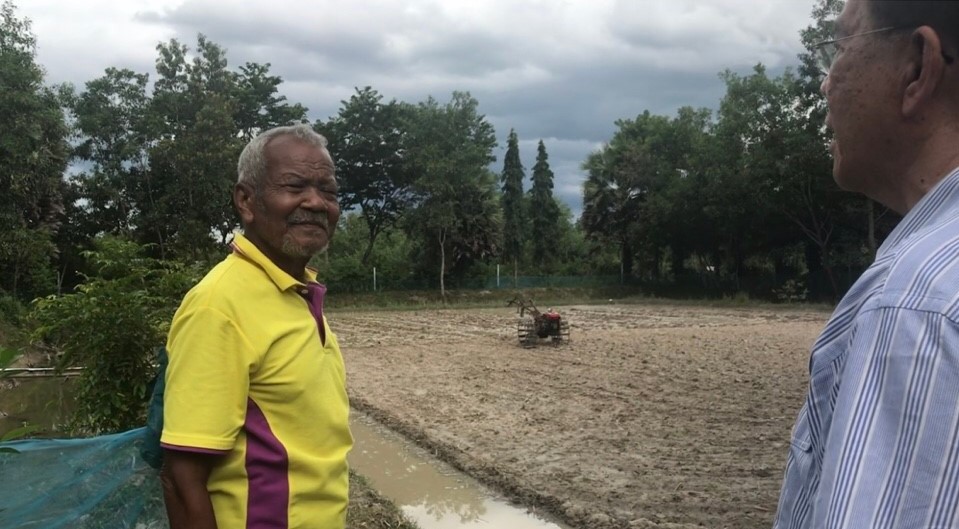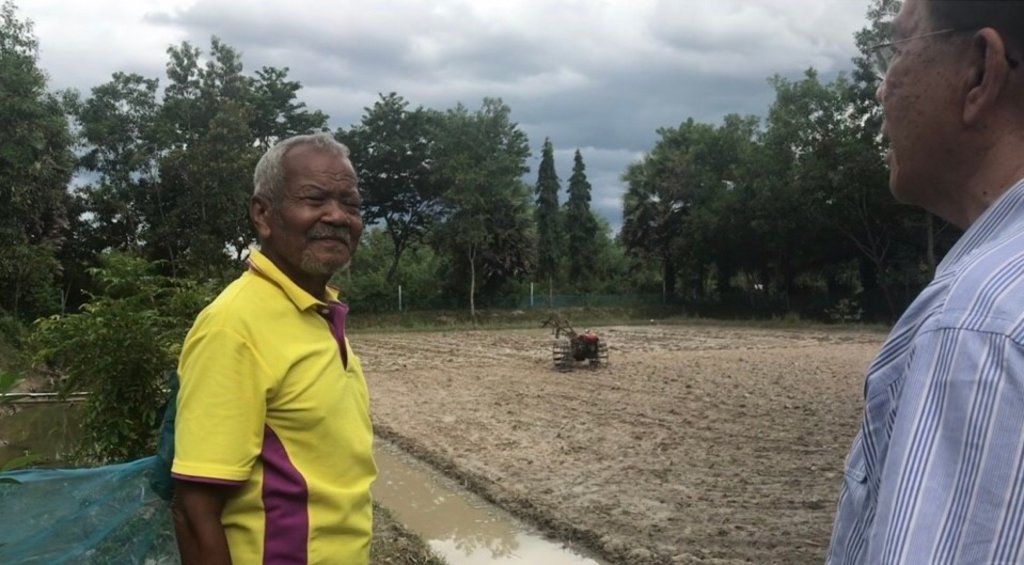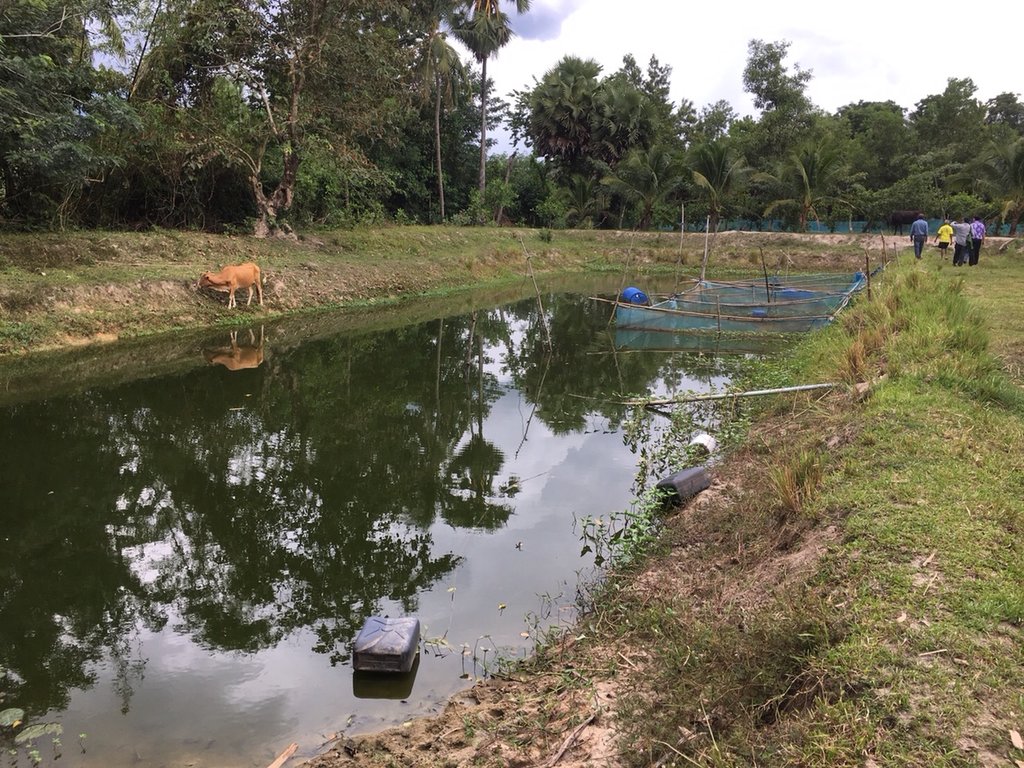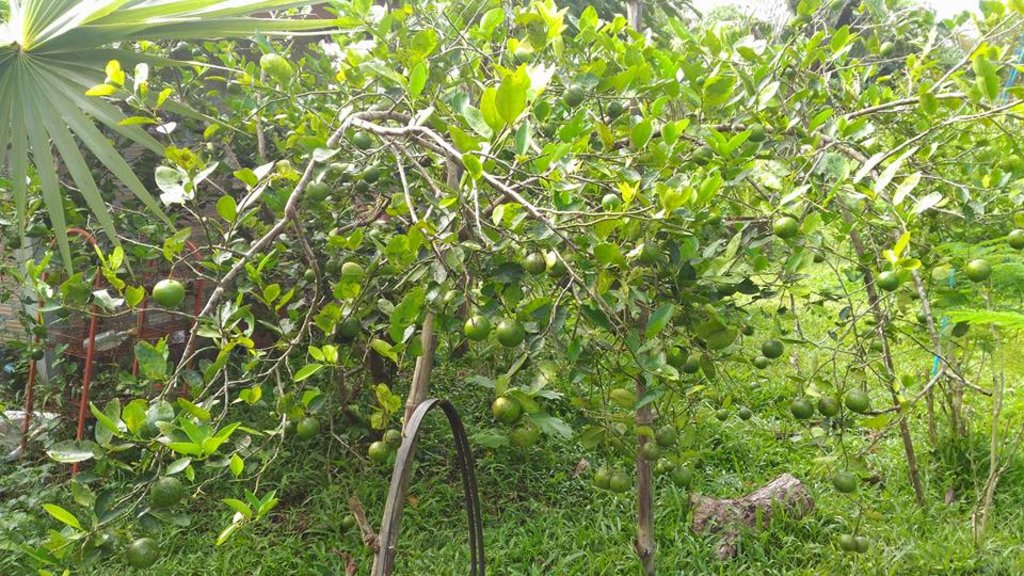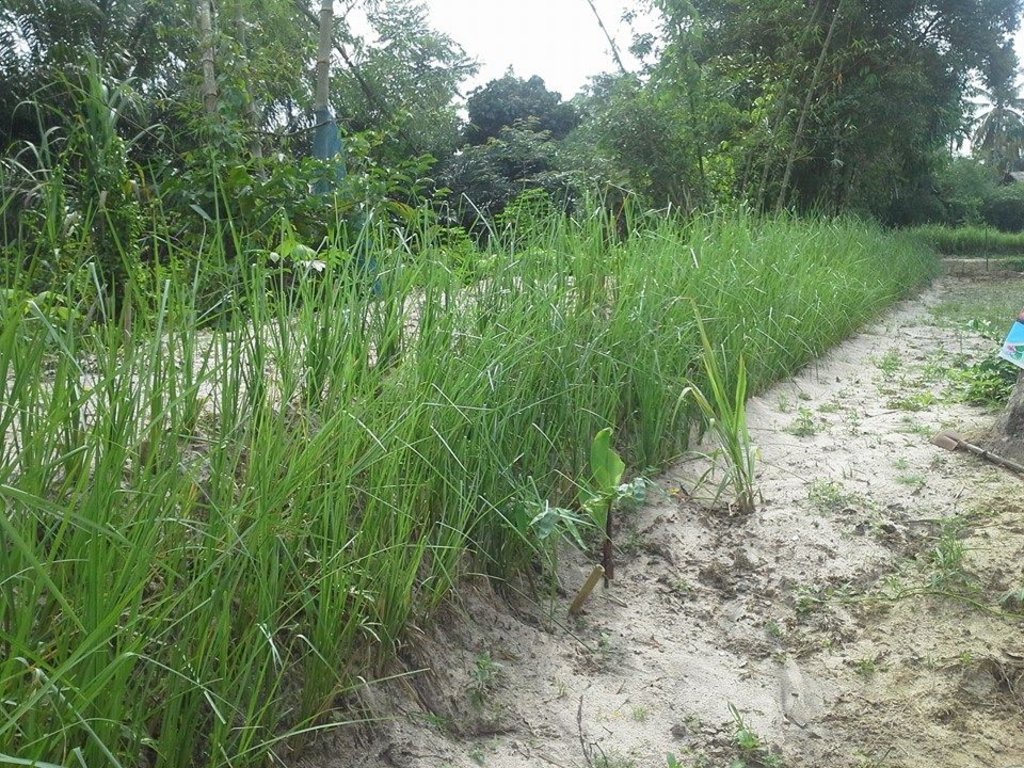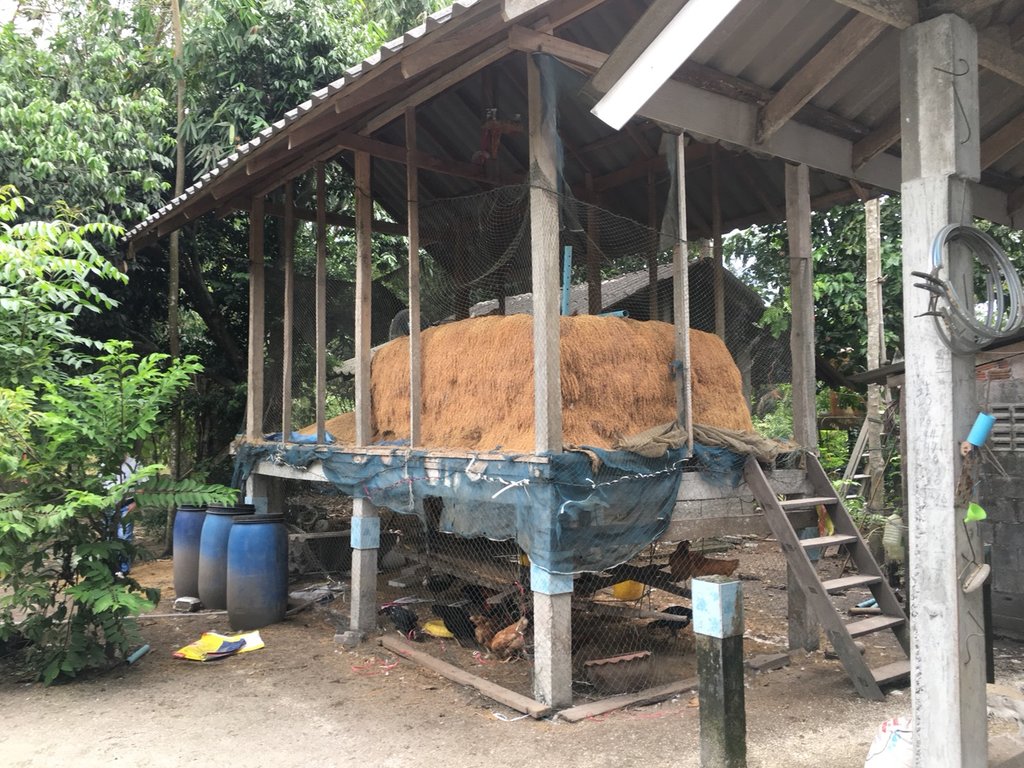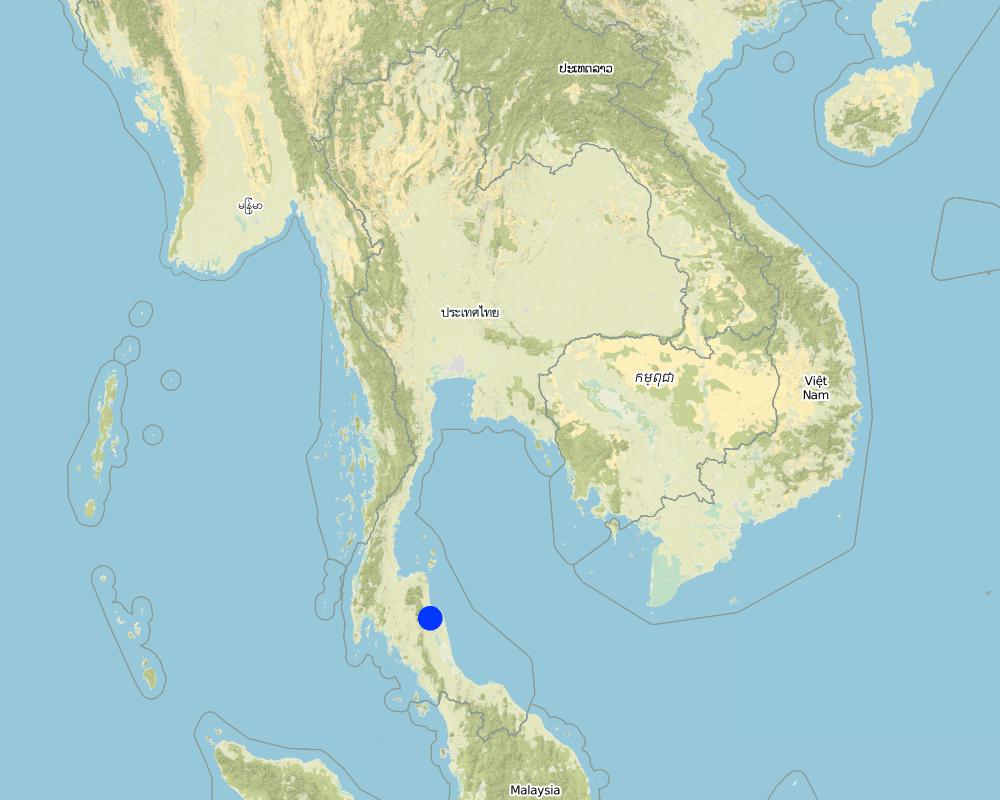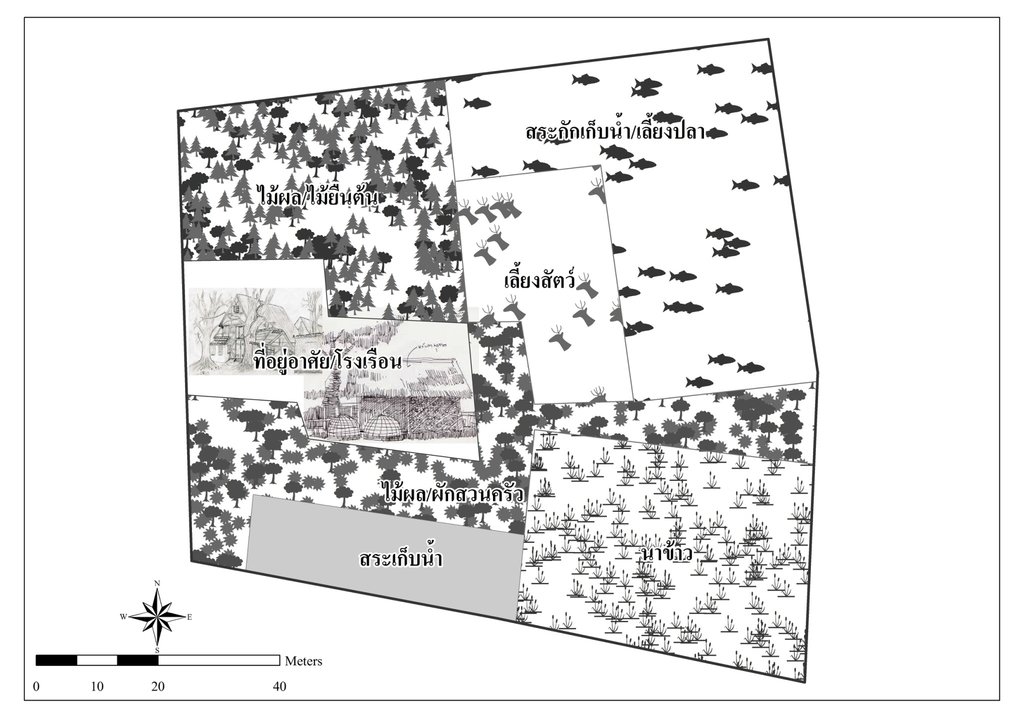The new theory of agriculture for mixed farming system [تايلاند]
- تاريخ الإنشاء:
- تحديث:
- جامع المعلومات: Prapa Taranet
- المحرر: –
- المُراجع: Rima Mekdaschi Studer
The royal new theory of agriculture
technologies_4146 - تايلاند
عرض الأقسام
توسيع الكل طي الكل1. معلومات عامة
1.2 تفاصيل الاتصال بالأشخاص الرئيسيين لمصدر المعلومات والمؤسسات المشاركة في تقييم وتوثيق التقنية
الشخص (الأشخاص) الرئيسي لمصدر المعلومات
مستخدم الأرض:
Singhophon Chaung
تايلاند
اسم المشروع الذي سهّل توثيق/تقييم التقنية (إذا كان ذلك على صلة)
Decision Support for Mainstreaming and Scaling out Sustainable Land Management (GEF-FAO / DS-SLM)اسم المؤسسة (المؤسسات) التي سهلت توثيق/تقييم التقنية (إذا كان ذلك على صلة)
Land Development Department (Land Development Department) - تايلاند1.3 الشروط المتعلقة باستخدام البيانات الموثقة من خلال WOCAT
يوافق جامع المعلومات والشخص (لاشخاص) الرئيسي لمصدر المعلومات على الشروط المتعلقة باستخدام البيانات الموثقة من خلال WOCAT:
نعم
1.4 إعلان بشأن استدامة التقنية الموصوفة
هل التقنية الموصوفة هنا تمثل مشكلة فيما يتعلق بتدهور الأراضي، بحيث لا يمكن إعلانها تقنية مستدامة لإدارة الأراضي؟:
كلا
2. وصف تقنيةالإدارة المستدامي للأراضي
2.1 وصف مختصر للتقنية
تعريف التقنية:
Allocating and managing small-scale farm areas to make it be able to use for agricultural production with the highest efficiency
2.2 وصف تفصيلي للتقنية
الوصف:
The new theory of agriculture is the application of mixed farming systems to poor farmers on small land holdings in Chang Sai sub-district, Phra Phrom district, Nakhon Si Thammarat province, Thailand. The most important concept of new theory farming is an efficient allocation of land to serve the different needs of farm households, including paddy fields, farm ponds for water and fishes, and cash crops, fruit trees, and trees for farm income, plus a residential area. It has a goal to solve the problem of shortage of land and water resources, which is a very important problem in Thailand, for making a living of smallholder farmers. Apart from the fact that the size of the area and water resources are the limit factors for farmers in this area, the land is also degraded causing by both natural and human activities. The area is classified as sand dunes with low to very low soil fertility where farmers mostly grew same plant species in the whole area during the rainy season of every year. This results in high risks in regard to a fluctuation of the amount of production and insufficient food crop production for household consumption. Therefore, land allocation for agriculture under the concept of the new theory agriculture can be the appropriate measure in making use of resources of small-scale areas for optimal benefits and increase incomes for a household. Nowadays, farmers in the adjacent area realized the benefits obtained from allocating the area, they formed a group of farmers in order to set up management, improve the use of their small-scale areas for optimal benefits.
The new agricultural theory was initiated by His Majesty the Late King Bhumibol Adulyadej of Thailand to provide help for farmers who had small-scale areas for agricultural purposes. For the land allocation, the land is divided into 4 parts. Part 1 is designated for a pond to store rainwater during the rainy season and to supply water to grow crops in the dry season as well as for raising aquatic animals (fishes, field crabs) and plants (such as morning glory, water mimosa, etc.). Part 2 is set aside for rice cultivation during the rainy season as a daily staple in households throughout the year sufficiently, which cut down on expenses and allow the farmers to be self-reliant. Part 3 is used for growing fruit and bearing trees, perennials, vegetables, field crops for daily consumption. If any surplus from consumption, it can be sold. Part 4 is used for dwelling, animal husbandry, roads and other structures (barn, straw, pile of compost, houses, mushroom nurseries, stalls, flowering-plants, ornamental plants, home-grown vegetables of backyard gardens). In any case, the proportion of the area in each section can be adjusted for either increase or decrease depending on the suitability of area conditions of each location and the necessity of farmers who make use of the area, but it is usually 30:30:30:10.
2.3 صور التقنية
2.5 البلد/المنطقة/المواقع التي تم تنفيذ التقنية فيها والتي يغطيها هذا التقييم
البلد:
تايلاند
المنطقة/الولاية/المحافظة:
Nakhon Si Thammarat province
مزيد من التفاصيل حول الموقع:
Chang Sai sub-district, Phra Phrom district
حدد انتشار التقنية:
- يتم تطبيقها في نقاط محددة/ تتركز على مساحة صغيرة
هل يقع موقع/مواقع التقنية في منطقة محمية بشكل دائم؟:
كلا
Map
×2.6 تاريخ التنفيذ
اذكر سنة التنفيذ:
2010
2.7 إدخال التقنية
حدد كيف تم إدخال التقنية:
- من خلال المشاريع/ التدخلات الخارجية
التعليقات (نوع المشروع، الخ):
This technology was initiated by His Majesty the Late King Bhumibol Adulyadej of Thailand and disseminated to farmers by several departments under Ministry of Agriculture and Cooperatives
3. تصنيف تقنية الإدارة المستدامي للأراضي
3.1 الغرض الرئيسي ( الأغراض الرئيسية) للتقنية
- تحسين الإنتاج
- الحد من تدهور الأراضي ومنعه وعكسه
- خلق أثر اقتصادي مفيد
3.2 نوع (أنواع) استخدام الأراضي الحالية حيث يتم تطبيق التقنية
استخدامات الأراضي مختلطة ضمن نفس وحدة الأرض:
كلا

الأراضي الزراعية

غير ذلك
حدد:
Mixed farming system
ملاحظات:
cropland mixed with aquatic animals
التعليقات:
Crops include rice, vegetable, limes, tropical fruits, and trees, while aquatic animals include a variety of fishes, field crabs.
3.3 هل تغير استخدام الأراضي نتيجة لتنفيذ التقنية؟
هل تغير استخدام الأراضي نتيجة لتنفيذ التقنية؟:
- نعم (يرجى ملء الأسئلة أدناه فيما يتعلق باستخدام الأراضي قبل تنفيذ التقنية)
استخدامات الأراضي مختلطة ضمن نفس وحدة الأرض:
كلا

الأراضي الزراعية
- زراعة سنوية
الزراعة السنوية - حدد المحاصيل:
- الحبوب - الأرز (الأراضي الرطبة)
هل يتم ممارسة الزراعة البينية؟:
كلا
هل تتم ممارسة تناوب المحاصيل؟:
كلا
3.4 إمدادات المياه
إمدادات المياه للأرض التي يتم تنفيذ التقنية عليها:
- بعلية
3.5 مجموعةالإدارة المستدامة للأراضي التي تنتمي إليها هذه التقنية
- حصاد المياه
- حدائق منزلية
3.6 التدابير التقنية في مجال إلادارة المستدامة للأراضي

التدابير الزراعية
- A1: الغطاء النباتي/التربة
- A2: المادة العضوية/خصوبة التربة

التدابير النباتية
- V2: الأعشاب والنباتات العشبية المعمرة

التدابير البنيوية
- S5: السدود، الأحواض الصغيرة، البرك

التدابير الإدارية
- M2: تغيير في مستوى الإدارة/الكثافة

تدابير أخرى
حدد:
Introduction of aquatic animal
3.7 الأنواع الرئيسية من تدهور الأراضي التي تناولتها التقنية

التدهور الكيميائي للتربة
- (Cn): تراجع الخصوبة وانخفاض محتوى المادة العضوية (غير ناتج عن الانجراف)

تدهور المياه
- (Ha): التجفيف
3.8 منع أو حد أو عكس تدهور الأراضي
تحديد هدف التقنية فيما يتعلق بتدهور الأراضي:
- الحد من تدهور الأراضي
4. المواصفات الفنية، وأنشطة التنفيذ، والمدخلات، والتكاليف
4.1 الرسم الفني للتقنية
المواصفات الفنية (المتعلقة بالرسم الفني):
Land allocation according to new theory of agriculture in the area with the size of 5.3 rai of informants by dividing the land into 4 parts, first part is the ponds accounting for 1.5 rai (about 28% of the total area), second part is paddy field accounting for 1 rai (about 19% of the total area), third part is for growing fruit-bearing trees, home-grown vegetables, perennials accounting for 1.3 rai (about 25% of the total area) and last is for building construction for dwelling, animal husbandry and other constructions accounting for 1.5 rai ( about 28% of the total area).
المؤلف:
Prapa Taranet
التاريخ:
20/09/2018
4.2 معلومات عامة بخصوص حساب المدخلات والتكاليف
حدد كيفية احتساب التكاليف والمدخلات:
- حسب مساحة تنفيذ التقنية
الإشارة إلى حجم ووحدة المساحة:
5.3
في حالة استخدام وحدة مساحة محلية، قم بالإشارة إلى عامل التحويل إلى هكتار واحد (على سبيل المثال، 1 هكتار = 2.47 فدان): 1 هكتار =:
6.5
عملة أخرى/ عملة وطنية (حدد):
Baht
إذا كان ذا صلة، وضح سعر الصرف من الدولار الأمريكي إلى العملة المحلية (على سبيل المثال، 1 دولار أمريكي = 79.9 ريال برازيلي): 1 دولار أمريكي =:
33,0
اذكر متوسط تكلفة أجر العمالة المستأجرة في اليوم الواحد:
300 Baht
4.3 أنشطة التأسيس
| النشاط | التوقيت (الموسم) | |
|---|---|---|
| 1. | Pond construction | dry season |
| 2. | Labours | rainy season |
| 3. | Seeds | rainy season |
| 4. | Seedling | rainy season |
| 5. | Aqautic animals (fishes and field crabs) | rainy season |
4.4 التكاليف والمدخلات اللازمة للتأسيس
| تحديد المدخلات | الوحدة | الكمية | التكاليف لكل وحدة | إجمالي التكاليف لكل مدخل | % من التكاليف التي يتحملها مستخدمو الأراضي | |
|---|---|---|---|---|---|---|
| العمالة | Cultivation | days | 60,0 | 300,0 | 18000,0 | 100,0 |
| معدات | Hiring tractors for pond construction | ponds | 3,0 | 16000,0 | 48000,0 | 70,0 |
| المواد النباتية | Seeds | Kilogram | 300,0 | 10,0 | 3000,0 | |
| المواد النباتية | Seedlings | Plants | 100,0 | 50,0 | 5000,0 | 80,0 |
| الأسمدة والمبيدات الحيوية | Compost | Ton | 1,0 | 2500,0 | 2500,0 | 50,0 |
| مواد البناء | Roof tiles | each | 240,0 | 60,0 | 14400,0 | |
| مواد البناء | Cement | bags | 8,0 | 100,0 | 800,0 | |
| مواد البناء | Sand and rocks | ton | 1,0 | 1650,0 | 1650,0 | |
| مواد البناء | Pillars | each | 12,0 | 100,0 | 1200,0 | |
| غير ذلك | Fishes and crabs | each | 2500,0 | 1,0 | 2500,0 | |
| إجمالي تكاليف إنشاء التقنية | 97050,0 | |||||
| إجمالي تكاليف إنشاء التقنية بالدولار الأمريكي | 2940,91 | |||||
إذا تحمل مستخدم الأرض أقل من 100% من التكاليف، حدد من قام بتغطية التكاليف المتبقية:
Government agencies
4.5 الصيانة/الأنشطة المتكررة
| النشاط | التوقيت/الوتيرة | |
|---|---|---|
| 1. | Labours | throughout the year |
| 2. | Seeds | rainy season |
| 3. | Seedlings | rainy season |
| 4. | Aquatic animal | 9 months |
4.6 التكاليف والمدخلات اللازمة للصيانة/للأنشطة المتكررة (سنويًا)
| تحديد المدخلات | الوحدة | الكمية | التكاليف لكل وحدة | إجمالي التكاليف لكل مدخل | % من التكاليف التي يتحملها مستخدمو الأراضي | |
|---|---|---|---|---|---|---|
| العمالة | Cultivation | days | 260,0 | 300,0 | 78000,0 | 100,0 |
| العمالة | Cultivation | days | 260,0 | 300,0 | 78000,0 | 100,0 |
| الأسمدة والمبيدات الحيوية | Compost | ton | 1,0 | 2500,0 | 2500,0 | 50,0 |
| غير ذلك | Fishes and crabs | each | 5000,0 | 1,0 | 5000,0 | 30,0 |
| غير ذلك | Feeding | month | 9,0 | 5000,0 | 45000,0 | 100,0 |
| إجمالي تكاليف صيانة التقنية | 208500,0 | |||||
| إجمالي تكاليف صيانة التقنية بالدولار الأمريكي | 6318,18 | |||||
إذا تحمل مستخدم الأرض أقل من 100% من التكاليف، حدد من قام بتغطية التكاليف المتبقية:
Government agencies support some inuts
4.7 أهم العوامل المؤثرة على التكاليف
قدم وصفا لأهم العوامل التي تؤثر على التكاليف:
Water - if there is a lack of water during the dry season, some agricultural activities may not be practiced. This leads to a reduction of agricultural cost; however, this also leads to a reduction of a household income during that period.
5. البيئة الطبيعية والبشرية
5.1 المناخ
هطول الأمطار السنوي
- < 250 مم
- 251- 500 ملم
- 501 - 750ملم
- 1,000-751 ملم
- 1,500-1,100 ملم
- 2,000-1,500 ملم
- 3,000-2,001 ملم
- 4,000-3,100 ملم
- > 4000 ملم
حدد متوسط هطول الأمطار السنوي (إذا كان معروفًا)، بالملليمتر:
274,00
الإشارة إلى اسم محطة الأرصاد الجوية المرجعية المعنية:
Nakhon Si Thammarat meteorological station
المنطقة المناخية الزراعية
- شبه رطبة
5.2 طوبوغرافيا
متوسط الانحدارات:
- مسطح (0-2%)
- بسيط (3-5%)
- معتدل (6-10%)
- متدحرج (11-15%)
- تلال (16-30%)
- شديدة الانحدار(31-60%)
- فائقة الانحدار (>60%)
التضاريس:
- هضاب/سهول
- أثلام مرتفعة
- المنحدرات الجبلية
- منحدرات التلال
- منحدرات في السفوح
- قاع الوادي
المنطقة الارتفاعية:
- 100-0 متر فوق سطح البحر
- 500-101 متر فوق سطح البحر
- 1,000-501 متر فوق سطح البحر
- 1,500-1,001 متر فوق سطح البحر
- 2,000-1,501 متر فوق سطح البحر
- 2,500-2,100 متر فوق سطح البحر
- 3,000-2,501 متر فوق سطح البحر
- 4,000-3,001 متر فوق سطح البحر
- > 4000 متر فوق سطح البحر
وضح ما إذا كانت التقنية مطبقة على وجه التحديد في:
- غير ذات صلة
5.3 التربة
متوسط عمق التربة:
- ضحل جدًا (0-20 سم)
- ضحلة (21-50 سم)
- متوسطة العمق (51-80 سم)
- عميقة (81-120 سم)
- عميقة جدًا (> 120 سم)
قوام التربة (التربة السطحية):
- خشن / خفيف (رملي)
قوام التربة (> 20 سم تحت السطح):
- خشن / خفيف (رملي)
المواد العضوية في التربة السطحية:
- منخفضة (<1%)
إذا كان متاحًا، قم بإرفاق وصف كامل للتربة أو تحديد المعلومات المتوفرة، على سبيل المثال نوع التربة، الرقم الهيدروجيني/ درجة حموضة التربة، قدرة التبادل الكاتيوني، النيتروجين، الملوحة وما إلى ذلك.
The soil in this area is sandy soil, classified into Coated, isohyperthermic and Typic Quartzipsamments. The parent material is beach ridge or sand dune. The area condition is quite flat up to little undulating with the slope of 1.5%. The soil is very deep and well drained. Water permeability is fast but runoff on the soil surface occurs slowly. The soil reaction is very acidic to a little acidic (pH 5.0 - 6.5) throughout the soil profile. The soil fertility is low. Land use limitation is low fertility and a shortage of water.
5.4 توافر المياه ونوعيتها
منسوب المياه الجوفية:
50-5 م
توافر المياه السطحية:
متوسط
نوعية المياه (غير المعالجة):
للاستخدام الزراعي فقط (الري)
تشير جودة المياه إلى:
المياه السطحية
هل تعتبر ملوحة الماء مشكلة؟:
كلا
هل تحدث فيضانات في المنطقة؟:
كلا
5.5 التنوع البيولوجي
تنوع الأنواع:
- متوسط
تنوع الموائل:
- متوسط
5.6 خصائص مستخدمي الأراضي الذين يطبقون التقنية
مستقر أو مرتحل:
- غير المترحل
التوجه السوقي لنظام الإنتاج:
- مختلط (كفاف/ تجاري)
الدخل من خارج المزرعة:
- أقل من % 10من كامل الدخل
المستوى النسبي للثروة:
- متوسط
أفراداً أو مجموعات:
- فرد/أسرة معيشية
مستوى المكننة:
- عمل يدوي
الجنس:
- رجال
عمر مستخدمي الأرضي:
- كبار السن
5.7 متوسط مساحة الأرض التي يستخدمها مستخدمو الأراضي الذين يطبقون التقنية
- < 0.5 هكتارا
- 0.5 - 1 هكتار
- 1 -2 هكتار
- 2 - 5 هكتار
- 5 - 15 هكتار
- 15 - 50 هكتار
- 50 - 100هكتار
- 500-100 هكتار
- 1,000-500 هكتار
- 10,000-1,000 هكتار
- > 10,000 هكتار
هل يعتبر هذا نطاقًا صغيرًا أو متوسطًا أو واسعا (في إشارة إلى السياق المحلي)؟:
- على نطاق صغير
5.8 ملكية الأراضي، وحقوق استخدام الأراضي، وحقوق استخدام المياه
ملكية الارض:
- فردية، يوجد سند ملكية
حقوق استخدام الأراضي:
- فردي
حقوق استخدام المياه:
- فردي
5.9 الوصول إلى الخدمات والبنية التحتية
الصحة:
- ضعيف
- معتدل
- جيد
التعليم:
- ضعيف
- معتدل
- جيد
المساعدة التقنية:
- ضعيف
- معتدل
- جيد
العمل (على سبيل المثال خارج المزرعة):
- ضعيف
- معتدل
- جيد
الأسواق:
- ضعيف
- معتدل
- جيد
الطاقة:
- ضعيف
- معتدل
- جيد
الطرق والنقل:
- ضعيف
- معتدل
- جيد
مياه الشرب وخدمات الصرف الصحي:
- ضعيف
- معتدل
- جيد
الخدمات المالية:
- ضعيف
- معتدل
- جيد
6. الآثار والتصريحات الختامية
6.1 الآثار التي أظهرتها التقنية في الموقع
الآثار الاجتماعية والاقتصادية
الإنتاج
إنتاج المحاصيل
الكمية قبل الإدارة المستدامة للأراضي:
100
الكمية بعد الإدارة المستدامة للأراضي:
500
التعليقات/ حدد:
Considering from rice production in 1 rai
جودة المحاصيل
خطر فشل الإنتاج
التعليقات/ حدد:
As farmer allocates the land to different types of crop, they can evaluate the suitable types of crops for the markets and climatic conditions
توافر المياه ونوعيتها
توافر المياه للماشية
توافر مياه الري
التعليقات/ حدد:
Rainwater can be collected in the ponds and this could supply to cultivation during the dry season
الدخل والتكاليف
النفقات على المدخلات الزراعية
دخل المزرعة
تنوع مصادر الدخل
عبء العمل
الآثار الاجتماعية والثقافية
المعرفة بالإدارة المستدامة للأراضي/تدهور الأراضي
التعليقات/ حدد:
The knowledge about SLM comes through the support of the government agencies
الآثار الايكولوجية
التربة
رطوبة التربة
غطاء التربة
المادة العضوية في التربة/تحت الطبقة c
التعليقات/ حدد:
Application of compost in the farm leads to an increase in soil organic matter
التنوع البيولوجي: الغطاء النباتي، الحيوانات
الأنواع المفيدة
التعليقات/ حدد:
Earthworms, Birds, Bees, Cicada, and Varanus.
6.2 الآثار التي أظهرتها التقنية خارج الموقع
تلوث المياه الجوفية/الأنهار
التعليقات/ حدد:
Agrichemical products did not apply to the farmland, resulting in less soil contamination to environment
6.3 تعرض التقنية وحساسيتها لتغير المناخ التدريجي والظواهر المتطرفة/الكوارث المرتبطة بالمناخ (كما يراها مستخدمو الأراضي)
تغير مناخ تدريجي
تغير مناخ تدريجي
| الموسم | زيادة أو نقصان | كيف تتعامل التقنية مع ذلك؟ | |
|---|---|---|---|
| درجة الحرارة الموسمية | الصيف | زيادة | باعتدال |
6.4 تحليل التكلفة والعائد
كيف يمكن مقارنة العوائد نسبة لتكاليف الإنشاء (من وجهة نظر مستخدمي الأراضي)؟
عوائد قصيرة الأجل:
محايد/متوازن
عوائد طويلة الأجل:
إيجابي
كيف تتم مقارنة العوائدمع كلفة الصيانة/التكاليف المتكررة (من وجهة نظر مستخدمي الأراضي)؟
عوائد قصيرة الأجل:
إيجابي
عوائد طويلة الأجل:
إيجابي
6.5 اعتماد التقنية
- 11-50%
إذا كان متاحًا، قم بتحديد الكمية (عدد الأسر المعيشية و/أو المساحةالمغطاة):
Members in the community (about 50-60 households in the community) and parts of the outside community nearby show interest in this technology because they see that it can increase household incomes and start to implement it in their own areas. However, allocation of the land differs according to the area conditions and the needs of the owners themselves.
من بين جميع الذين تبنوا التقنية، كم عدد الذين فعلوا ذلك بشكل تلقائي، أي دون تلقي أي حوافز مادية/مدفوعات؟:
- 10-0%
التعليقات:
The government provides some inputs for farmers who want to apply this technology to their farmland such as fishes and rice seeds. Then most farmers get some support before they start the activity on the farm.
6.6 التكيف
هل تم تعديل التقنية مؤخرًا لتتكيف مع الظروف المتغيرة؟:
نعم
إذا كانت الإجابة بنعم، وضح الظروف المتغيرة التي تم تكييفها معها:
- الأسواق المتغيرة
حدد تكيف التقنية(التصميم، المواد/الأنواع، الخ.):
Since organic markets get bigger in the areas, then some farmers produce their products without using agrichemical products. This allows farmers to improve the price for their products.
6.7 نقاط القوة / المزايا / الفرص التي توفرها التقنية
| نقاط القوة/ المزايا/ الفرص من وجهة نظر مستخدمي الأراضي |
|---|
| Water can be available even in the dry season since this technology includes the farm pond construction for rainwater storage. |
| Farmers should be able to grow enough rice for the whole year’s consumption. |
| Production planning can be done for the household consumption and supply to the market. |
| نقاط القوة/ المزايا/ الفرص من وجهة نظر جامع المعلومات أو غيره من الاشخاص الرئيسيين لمصدر المعلومات |
|---|
| Allocation of the land into 4 parts according to the new theory of agriculture is considered an appropriate option for smallholder farmers who are having small farmland and water shortage. This is due to they can plan what crops, and when, to grow for each growing season based on climatic condition and market. Importantly, farmers learn how to plan the production that will be distributed to the market and for making a living. |
6.8 نقاط ضعف / مساوىء / مخاطر التقنية وسبل التغلب عليها
| نقاط الضعف/ المساوىء/ المخاطر من وجهة نظر مستخدم الأراضي | كيف يمكن التغلب عليها؟ |
|---|---|
| A lack of household labor results in some farmers adopted only part of technology where the efficiency of this technology may be lower than the adoption of full management. | Mose farmers hire labor or mechanical equipment to help them farming. although this increases the farming cost, it helps farmers to get their work done in time. |
| The cost of investment is rather high, especially for digging the pond. | Farmers ask the support from the government. While some farmers receive 80% help from the government, foundations, and the private sector for digging the ponds, others receive less support from the government. |
| Farmers have limited land for farming, to allocate the land to usual allocation as recommendation may not be suitable. | Farmers changed or improved the allocation ratio by themselves based on the land conditions, climatic condition, and the environment. For example, some farmers who have enough water sources in their areas, the size of the pond can be reduced to make room for other uses. |
| نقاط الضعف/ المساوىء/ المخاطر من وجهة نظر جامع المعلومات أو غيره من الاشخاص الرئيسيين لمصدر المعلومات | كيف يمكن التغلب عليها؟ |
|---|---|
| Due to the fact that managing the area with many activities may require more time to take action than monoculture farming, which cannot interest some farmers to practice. Furthermore, it may take time to make it worth the paid expenses due to complexity, little understanding, insufficient labor force, and more hiring may require. | The government needs to take action in the areas to provide more knowledge on this technology and find the solution to the problems. |
7. المراجع والروابط
7.1 طرق جمع/مصادر المعلومات
- زيارات ميدانية، مسوحات ميدانية
1
- مقابلات مع مستخدمي الأراضي
1
- مقابلات مع المتخصصين/الخبراء في الإدارة المستدامة للأراضي
1
متى تم تجميع البيانات (ميدانيا)؟:
20/09/2018
7.2 المراجع للمنشورات المتاحة
العنوان، المؤلف، السنة، النظام القياسي الدولي لترقيم الكتب ISBN:
New Theory of Agriculture, 2011, Office of the Royal Development Projects Board.
متاح من أين؟كم التكلفة؟:
http://www.rdpb.go.th/UploadNew/Documents/%E0%B8%97%E0%B8%A4%E0%B8%A9%E0%B8%8E%E0%B8%B5%E0%B9%83%E0%B8%AB%E0%B8%A1%E0%B9%88.pdf
العنوان، المؤلف، السنة، النظام القياسي الدولي لترقيم الكتب ISBN:
Implementation manual for new theory of agriculture, 2015, Ministry of Agriculture and Cooperatives.
متاح من أين؟كم التكلفة؟:
http://www3.oae.go.th/rdpcc/images/filesdownload/SUFFICIENCY/9.9.pdf
7.3 روابط للمعلومات ذات الصلة على الإنترنت
العنوان/الوصف:
Sufficiency Economy & New Theory
عنوان الرابط URL:
http://www.chaipat.or.th/eng/concepts-theories/sufficiency-economy-new-theory.html
7.4 تعليقات عامة
The long-term impact on household income might change or improve if they practice this technology longer period than 8 years.
الروابط والوحدات المواضيعية
توسيع الكل طي الكلالروابط
لا يوجد روابط
الوحدات المواضيعية
لا يوجد وحدات مواضيعية


